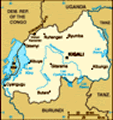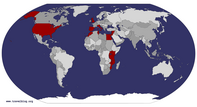Advertisement
Published: April 24th 2008
I’ve hooked up with an American staying at the auberge - a PhD student researching her dissertation on gender and post-genocide justice in Rwanda. Having put in time at the genocide tribunal in Arusha - and planning to spend the next month interviewing survivors around the country - Jenna proves to be good company for a few days around Kigali. She tells me about the Kagame government’s strict control of the genocide narrative, about the journalists and aid workers who have been unceremoniously booted from the country for asking the wrong people the wrong questions. There’s a sober diligence to how she recounts these stories, and the stories of the survivors she’s interviewed - a natural consequence, I suspect, of making a living in genocide justice. But she’s blessed with a quick, wicked laugh, and a wry humor that I recognize well from a certain class of American post-grad - hyper-educated, left-leaning, indignant in all the right ways when it comes to politics, power, and the rights of the oppressed. She’s also promised to give me some back issues of
Harper’s and
The New Yorker she’s brought along from New York - as auspicious a sign as any at the start
of this budding friendship.
We’ve hired a taxi for a few hours and head out late in the morning. It’s a beautiful day, clear and warm with a breeze blowing clouds across the hilltops. The streets are busy, people moving about with the brisk, businesslike manner of the Kigali workday. On the outskirts of the city we quickly come upon small adobe homes and broad, flat fields. Bare-chested men carry hoes and farm tools through the tall grass, stooping, whacking at the earth. Women with colorful parasols walk along the side of the road, their hair wrapped in brightly patterned scarves, babies gurgling in bundles on their backs. At Ntarama, leaving our car in the shade, we’re quickly surrounded by curious kids. Mothers smile approvingly, whispering “
Mzungu!” as they prod the reluctant ones our way.
Our guide is a young, soft-spoken girl wearing a neat, buttoned blouse and a baseball cap. Her name is Daitiva Kaitessi, and she’s 24, and most of her family was killed during the genocide. She takes us inside the church and stands quietly in the back, answering our questions in a hushed voice. The church is small and dark and littered
with the remains of the dead: piles of old, worn shoes; dirty shirts and blouses; torn skirts; dresses; rosaries and crucifixes; prayer books and Bibles. There are dusty bowls and mugs that the victims used for the three days they were trapped inside. There are pens and schoolbooks where the ink still looks fresh - grammar exercises in Kinyarwanda, the pages burnt and frayed at the edges. A small statue of Christ is propped against the wall. One of his arms ends at the wrist. A rosary hangs around his neck like a noose.
And the skeletons, too: the fibulas and femurs and pelvic bones, the skulls frozen in those ghastly, mocking smiles of the dead. They’re displayed on metal shelves - careful stacks of tibias, skulls lined up in neat, pious rows, like votives. Some are missing jaws, or have cracks and fissures running along the cranium. Withered flowers are strewn about, old bouquets with ribbons and sashes (“Never Again!”) wrapped around the stems. Jenna sits on one of the low benches in the back, hands clasped across her knee. I take a few pictures, and then take a few more. Looking at these horrors I feel curiously
detached - as if those broken remains are trying to communicate something, but I can’t recognize the words.
Outside, in the bright clear air full of children’s laughter and birdsong, I ask Daitiva how long she’s worked at the memorial. Two years, she says. What made her start working here to begin with? She smiles awkwardly and shrugs her shoulders.
“It’s a job,” she says.
We watch a few cows lowing and swishing their tails on the other side of the fence. I ask about her family.
“When the genocide started,” she says, “we tried to escape. My family went south. They never made it. I don’t know where their bones are.”
I wonder about the price she must pay to be here everyday, to tell these same stories while the tourists take pictures and offer their mumbled pieties. But would it be any different if she were working somewhere else? I ask about her friends: do they think about the genocide everyday?
“Oh yes,” she says. “Yes. We all do.”
Would she want a different job, if she could find one? She shrugs again and says, “This is what I know.”
I circle the memorial and startle a few birds perched on a window ledge. An old man pedals a bike down the road, his bearing grave and upright. From a neighboring yard I hear women bickering, busying themselves in the domestic dramas of daily life. Daitiva and Bosco, our driver, sit on a concrete bench and talk quietly, smiling, laughing. A group of small boys gathers outside, kicking around a soccer ball made from dirty rags and string. Farmers pass with shovels on their shoulders, watching warily, then breaking into broad grins and waving with both hands.
There’s a logic to our grief when it’s small, private. Families gather to share stories of the deceased. Tears are shed over the coffin. Fathers are remembered as proud, doting; mothers tireless, devoted to the kids. We laugh and cry and slowly learn to incorporate the fact of our loss into the process of our living. You can only grieve for so long, in the end. You take the pieces apart, and then you put them back together. But how do you recreate that process on such a large scale? How do you make a country whole again? On
an April morning fourteen years ago, as surely as they work the fields today, some of those smiling, waving farmers went about the task of killing their neighbors and friends with the same workaday diligence. They hacked at arms and necks and heads; they wiped the blood on the grass and went back to their families. Did they feel remorse as they killed? Did they wonder whose father or mother, whose brother or son, they had left for dead on the roadside?
And what do they carry around in their hearts today?
We’re quiet as we drive back across the hills, to the memorial at Nyamata. The countryside is alive with color, movement - farmers in the field, village women carrying baskets to market - and people crane their necks to watch us as we pass. In Nyamata, at a school near the church, schoolgirls in bright blue sweaters smile and wave and giggle at our car. The region around Nyamata was the site of some of the genocide’s worst violence - as many as 50,000 killed, according to some estimates. In the years before the genocide, the Interahamwe used the area to optimize their strategy for
killing. A thousand Tutsis, they decided, could be slaughtered every twenty minutes. A busy, eight-hour workday would leave more than 20,000 bodies behind.
Today the church is one of Rwanda’s largest memorials. A guide takes us inside, talking briskly, hands thrust deep into his pockets. Piles of clothes are stuffed into boxes of La Croix detergent and Jambo basmati rice and stacked against the wall. A few white and purple pennants hang limply from the rafters. You can almost imagine the congregation filing in and filling the pews, making plans for a Sunday barbecue or a food drive at the local primary school. There were thousands locked inside for those last, long hours: out of food and water, eyes lifted toward the Virgin Mary, hearing the distant gunshots and the militias at the gates.
The guide points to tiny holes in the roof left by grenade shrapnel, and to a blood-stained cloth draped across the altar, rattling off the numbers of the dead. He seems unmoved by this grim species of knowledge; it is, in effect, just another day at the office. He leads us into a cool, dark crypt beneath the nave, the walls white-tiled, the remains
arranged in glass-paned display cases. We circle the rows of skulls and bones, our own faces reflected dimly back at us. It is an odd, chilling place. Beneath the display, in a darkened sub-basement, Jenna points to a separate coffin shrouded in white. The guide leans forward to explain, then stops to take a call on his phone. He chatters away for a minute, laughing softly, then hangs up and tells us about the woman who was gang-raped by more than 100 men.
“They took a sharp piece of wood and inserted it in her private area, until it came out here,” he says, pointing to his mouth. Even by the genocide’s terrible standards, he explains, such a death demanded special remembrance. We go upstairs and sit quietly on the pews, Jenna leaning forward heavily on her knees. Later she’ll explain the blood stains spreading darkly across the floor: the same evidence of sexual assault she often saw working with rape victims in the States. Such brutal reminders were scattered throughout the church.
“You just have to know what to look for,” she says.
Advertisement
Tot: 0.349s; Tpl: 0.034s; cc: 25; qc: 133; dbt: 0.1513s; 1; m:domysql w:travelblog (10.17.0.13); sld: 1;
; mem: 1.4mb















Peregrine
Tyler Davis
Another one well done.
Kudos, Chris.